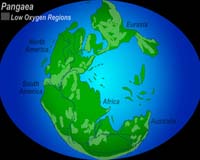Well, I can't think of a better title for this thread... so consider this a place to report and discuss the major happenings under our feet.
The most recent Indonesian quake is topping the headlines, but it is just another manifestation here on the surface of the turmoil going on within the earth.
I have seen one report which is really something extraordinary.
At Lake Vui on the island of Ambae in the Vanuatu Rebpulic in the Pacific Ocean there has been a major change which occured almost overnight.
The color of the lake turned from a turquoise-blue to a brilliant red.
"Vui" in the native language means poison and Lake Vui has always been a turquoise-blue lake with a high acidic content. Some unprecidented, chemical subterranean change has occured which has turned Lake Vui to a bright red color.
Associated Press
Volcano's Lake Turns From Blue to Red
By RAY LILLEY , 05.28.2006, 11:58 PM
A lake atop a rumbling volcano on the South Pacific island of Ambae has changed color from blue to bright red, puzzling scientists.
Mount Manaro, one of four active volcanos on the island nation of Vanuatu, has been showing signs of erupting for only the second time in 122 years.
"We are still ... trying to understand this change of color in the lake from blue to red," Geology and Mines Department director Esline Garae said by telephone Monday from Vanuatu's capital, Port Vila.
She said two scientists on Ambae Island were monitoring Lake Vui as well as seismic activity on the 5,000-foot Mount Manaro.
If the change of color "comes from new activity in the ground or just chemical change in the lake - these are two things I want to know from those guys before I can say anything" about the danger posed by the volcano, she said.
Mount Manaro last erupted in November 2005, forcing half the island's 10,000 inhabitants to evacuate their villages. An 1884 eruption killed scores of villagers.
New Zealand volcanologist Brad Scott said Lake Vui's color was "quite a spectacular red," but what had caused it "is the $64,000-question."
He said water samples from the lake would help determine what was happening in the crater and below it.
The color change could be a chemical process or gas from molten volcanic rock or something else coming into the lake, he said.
Three other volcanos in Vanuatu - Lopevi, Yasur and a two-crater volcano on Ambryn Island called Marum and Benbow - have spewed rocks, ash, smoke and steam in recent weeks.
Vanuatu, formerly the New Hebrides Islands, is made up of 13 main islands located about 1,400 miles east of Australia.
http://www.forbes.com/business/feeds...ap2778517.html
Ambae Volcano - John Seach
Ambae Island, Penama Province,
Vanuatu
15.38 S, 167.83 E,
summit elevation 1496 m
Shield Volcano
Ambae is an elipsoid shield volcano in northern Vanuatu. The island forms the upper part of the most voluminous volcano in Vanuatu. Ambae volcano rises 3900 m above the ocean floor and has a volume of 2500 cubic km. Ambae is atypical because it has a significant volume of pyroclastic products compared to other basaltic shield volcanoes.
Summit eruptions occurred at Ambae volcano in December 2005. People living in the north to the western side of the island reported smellingsulphuric fumes after an earthquake on February 16, 2005. There was an increase in water temperature at Ambae Volcano in 2000. Phreatic Eruptions occurred at Voui Crater Lake, Ambae in 1995
Eruptions of Ambae Volcano
2005, 1995 (lake degassing), 1914 (earthquake), 1870, 1670, 1575
Three summit crater lakes at Ambae volcano:
Lake Manaro Ngoru - 300 m diameter.
Lake Vui (Voui) - 2.1 km diameter.
Lake Manaro Lakua - 1.3 km diameter.
Note on terminology:
The correct name is Ambae Volcano.
Other names used - Manaro, Aoba, Omba, Lombenben.
http://www.volcanolive.com/ambae.html





 Reply With Quote
Reply With Quote


 Photo: California's Antelope Valley Freeway (Highway 14) cuts through the folded layers of the San Andreas Fault at Avenue S in Palmdale, Calif. (Roger Ressmeyer / Corbis file)
Photo: California's Antelope Valley Freeway (Highway 14) cuts through the folded layers of the San Andreas Fault at Avenue S in Palmdale, Calif. (Roger Ressmeyer / Corbis file) He said this lack of movement for 250 years correlated with the predicted gaps between major earthquakes at the southern end of the fault of between 200 and 300 years.
He said this lack of movement for 250 years correlated with the predicted gaps between major earthquakes at the southern end of the fault of between 200 and 300 years.



Bookmarks